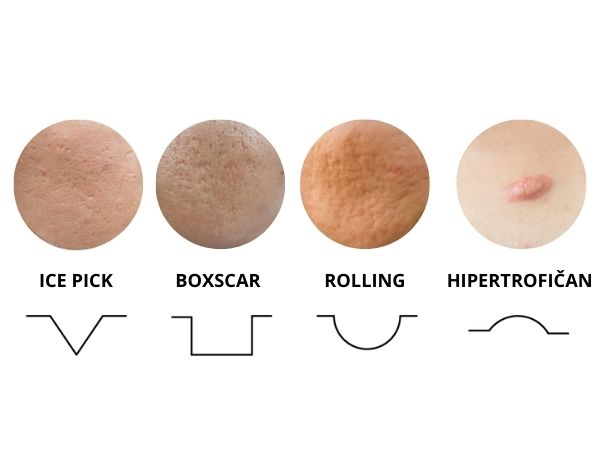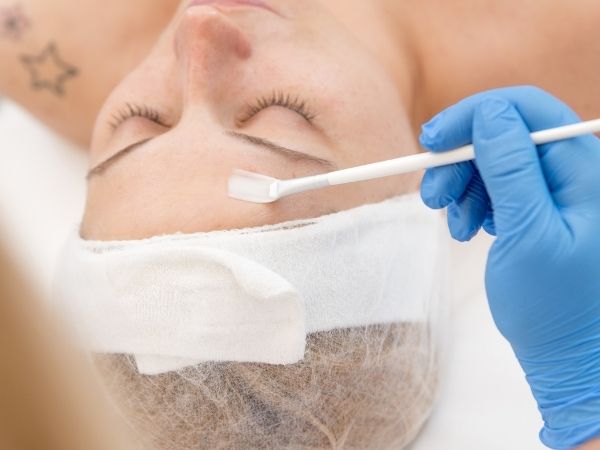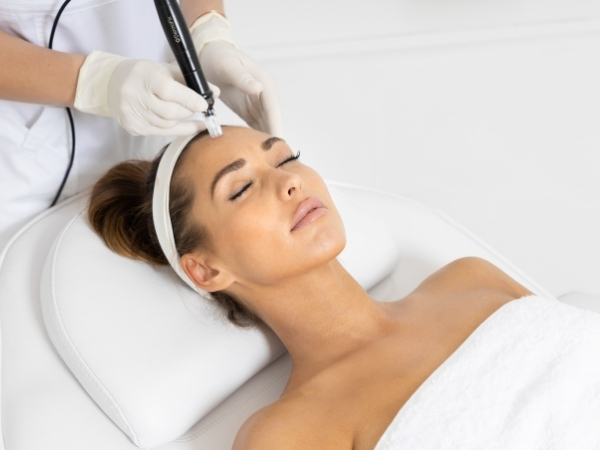Acne scars are a common skin problem that seriously influence on the self-confidence of adolescents and adults.
Types of acne scars
Most often, as a result of acne, atrophic scars are formed, which are depressions of the skin, caused by the destruction of collagen fibers and atrophy of the subcutaneous tissue. We distinguish 3 types of atrophic scars:
- Icepick scars are very narrow but extremely deep scars. They look like an icicle is pressed into the skin, which is how they got their name. They are the most demanding for treatments.
- Boxscar are wide scars with sharp edges, shaped like a hollow cube (box), which is how they got their name.
- Rolling scars are scars of different depth with unclear edges, due to which they give the skin a wavy appearance.
As a result of acne, hypertrophic and keloid scars can also occur. These are red, raised scars that are caused by disruptions during healing. They mostly appear on the back and chest.

How do scars form?
We often get questions about what the best laser is or what the best treatment is for acne scars. Each treatment has advantages and disadvantages, but for complex problems such as scars, an adequate combination of treatments is the right choice for the best result.
In order to understand how to treat scars and which treatments to choose, we must first understand how scars form. Moderate inflammations usually remain at the level of the skin, so the scars are shallow and affect only the skin without damaging the subcutaneous and fat tissue. However, inflammation in cystic and nodulocystic forms of acne also affects the subcutaneous tissue, and often the inflammatory reaction damages even fat tissue. As a result of damage, ie. atrophy of fat tissue is formed, which can be successfully solved only by adding the volume with fillers or fat transfer.
During inflammation, the body tries to limit the further spread of inflammation and start the “repair” the tissue in order to prevent further spread. This process is fast and very efficient, but this speed has its price, so the repair is done mainly at the expense of the connective tissue. In addition, fibosis often appears at the place of deeper inflammations. Fibrosis is a type of connective tissue that firmly binds the surface of the scar to the subcutaneous tissue. As the fibrous tissue matures, it changes and shrinks, pulling the scars even further towards the subcutaneous tissue and thus deepening them.
The best treatment for acne scars?
As we can see, scars are not only damage to the skin, but also to subcutaneous connective and fat tissue. The best treatment for acne scars involves smoothing the skin, stimulating collagen synthesis, filling scars, removing fibrosis and restoring volume. Since there is no treatment that works on all the problems mentioned above, the key to achieving a good result is a combination of methods.
Smoothing of the skin and stimulation of collagen synthesis, as well as filling of scars, are achieved with TCA peels and CO2 laser. Dermapen and dermaroller can also help fill in scars. To fill in the resulting atrophy of subcutaneous fat, we most often use fillers, while by subcision we separate the surface of the scar from the subcutaneous tissue and thus release the scar.
Acne scars removal with TCA PEEL
TCA PEEL (peeling with trichloroacetic acid) is the basic treatment in the treatment of acne scars. It is cheap, available and effective. For an optimal effect, it is necessary to use a percentage of 25-35% acid. Percentages higher than 35% on larger surfaces are more effective, however, they carry the risk of complications, so the use of a higher concentration is not recommended for the treatment of the entire face. In addition to the percentage of acid, the number of layers applied is also important.
The effectiveness of a TCA peel can be safely enhanced with a Jessner chemical peel . This peel consists of salicylic acid, lactic acid and resorcinol, and the procedure is such that the Jessner peel is applied first, and a few minutes later TCA in a concentration of 35%. In this way, the effects are obtained as if the treatment were done in a concentration of 50% without the risk of permanent complications. TCA peels are performed from the beginning of October to the end of March due to weaker UV radiation in order to avoid the appearance of hyperpigmentation and spots.

Acne scars removal with CO2 laser
Fractional CO2 laser is the gold standard in acne scar treatments. Fractional CO2 laser removes a certain percentage of the skin (from 1% to 95%, depending on the laser setting) but leaves a part of the skin intact, from which rapid regeneration and recovery is initiated. In our office, we use the Candela CO2 laser, which with its advanced modes of operation effectively reduces various types of acne scars.
What sets the CO2 laser apart from other CO2 lasers is the shorter pulse length, i.e. contact time of the laser beam with the skin. The longer the pulse length, the longer the laser beam makes contact with the skin, and thus the greater the thermal effect, i.e. greater damage to the surrounding skin. What does that mean in practice? The shorter pulse length of the CO2 laser enables the application of higher energy – it enables deeper penetration of the laser beam into the scar tissue, with less consequences for the surrounding healthy tissue. The result is a more effective, but at the same time safer treatment with a shorter recovery time.
Another important advantage of this laser is the special surgical attachment, which, in addition to surgery, is also used for the treatment of Icepick acne scars. Classic CO2 laser attachments direct the laser beam to the skin at a right angle. However, this special extension allows directing the laser beam at different angles, which allows us to treat both the walls and the base of Icepick scars and thus achieve a significantly better effect.
The interval between 2 CO2 laser scar removal treatments is a minimum of 2 months. Recovery after CO2 treatment is about 7 days, with redness on the scars itself lasting at least a month and easily hidden with tinted cream or powder. CO2 laser treatments are performed from the beginning of autumn to the beginning of spring. Read everything about fractional CO2 laser treatment here .

How effective are other lasers?
There are many different fractional lasers used in scar treatment, however it is important to note that only fractional CO2 lasers are powerful enough to produce visible scar reduction. Of all the fractional lasers, only the CO2 laser achieves better effects than TCA peeling. All other fractionated ablative and non-ablative lasers (fractionated erbium, non-ablative fractionated lasers such as Erbium Glass, ND:yag, Q-switched, etc.) improve the quality of the skin and the scar itself, but do not significantly affect the reduction of scars. An exception is vascular lasers (Vbeam, Yellow laser and others) which, even if they do not directly affect the depth of the scar, can remove the red color of scars, which is certainly useful in the treatment of scars.
Another group of lasers that achieve visible results in the treatment of acne scars are Full ablative Erbium laser or Full ablative CO2 lasers. These lasers remove 100% of the skin surface, which is why recovery is long and carries a higher risk of complications, so these lasers are used today only on small areas.
Acne scars removal with subcision
Subcision is an old method that re-enters in modern acne scar treatment protocols and is the only treatment that can resolve the adhesion of the scar to the subcutaneous tissue. It is an intervention during which the tight connection between the base of the scar on the skin and the subcutaneous tissue is broken with a needle or cannula. Cutting this, it frees the scar. In addition to releasing the scar itself, tissue injury during subcision initiates the process of skin regeneration, which further reduces scars.
We can enhance the effect of subcision with fillers, by applying a small amount of filler to that place after breaking the connection of the scar with the subcutaneous tissue, which fills the defect, but also creates a layer between the skin and the subcutaneous tissue that prevents fibrosis. The downside of this treatment is bruising and swelling, which is why many doctors and patients avoid the procedure. That problem is solved by using a blunt cannula – a special needle with a blunt tip that can break the connection of the base of the scar with the subcutaneous tissue, without major damage to the surrounding blood vessels, and therefore without large bruises and with a short recovery.
Subcision gives excellent results in combination with CO2 laser, where the interval between these two treatments is about 10 days (subcision is done first).

Removal of acne scars with dermapen
Dermapen treatments shows good results in the treatment of acne scars. Thin needles of dermapen make micro-injuries to the tissue, which leads to skin regeneration and reduction of scar depth. However, they are less than the results obtained with TCA peels, but the recovery after the treatment is much shorter and usually lasts 2-3 days.
Dermapen treatments are excellently combined with TCA peels. Especially good effects are obtained by applying dermapen between 2 peeling treatments. With this approach, we additionally stimulate skin regeneration.

Filling scars with hyaluronic fillers
Wide, sunken acne scars respond wonderfully to treatment with fillers. Hyaluronic fillers are an ideal procedure, as it is possible to almost completely eliminate acne scars in just one treatment. However, not all scars can be treated with hyaluronic fillers, only those that have sufficient width.
Before injecting the filler, it is important to perform a subcision first if there is an adhesion that pulls the scar down. In addition to hyaluronic fillers, fillers based on calcium hydroxyapatite can also be used to fill acne scars, which, in addition to the filling effect, also stimulate collagen synthesis, which additionally restores the appearance of the scar itself.
You can read everything about hyaluronic fillers by clicking on the link.
How long does recovery take?
The recovery period depends on the applied procedure and when it comes to hyaluronic fillers, there is practically no recovery period, and patients immediately return to their usual activities. Recovery after TCA peeling and fractionated lasers is 6-7 days, during which the skin is intensively scaly. After peeling, the recovery is complete, the skin looks younger, gentle and radiant. In the next 2-3 weeks, the epithelialization process ends and the scars become less and less visible. Exceptions are dermabrasion in combination with TCA peeling and more aggressive CO2 laser treatment, after which recovery takes 10-14 days.
Are the results permanent?
The results obtained with laser treatments and chemical peels are permanent.
price and additional questions?
Prices for acne scar removal treatments – CO2 laser, chemical peels, subcision, dermapen, fillers and more can be found on the Pricelist page. If you have additional questions or want to book an appointment, please call us at 060/345-0304 or write at estetikabgd@gmail.com.
